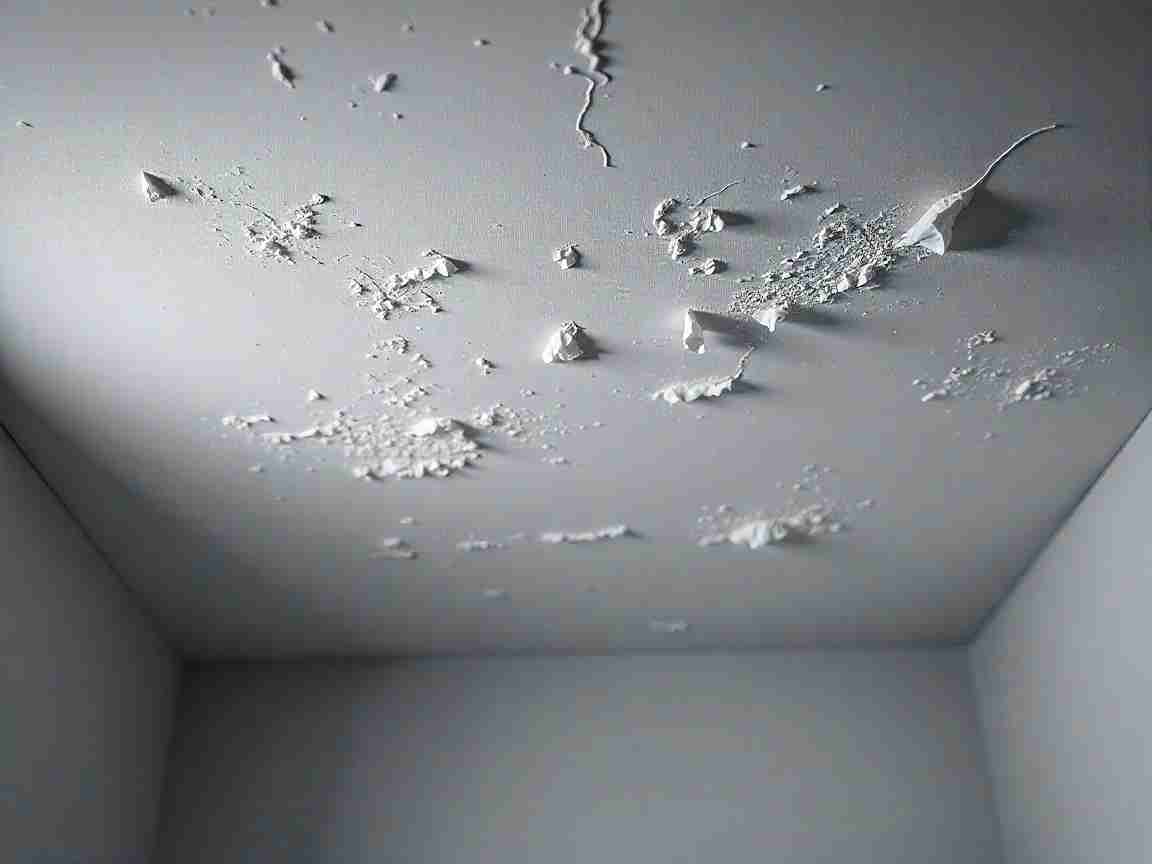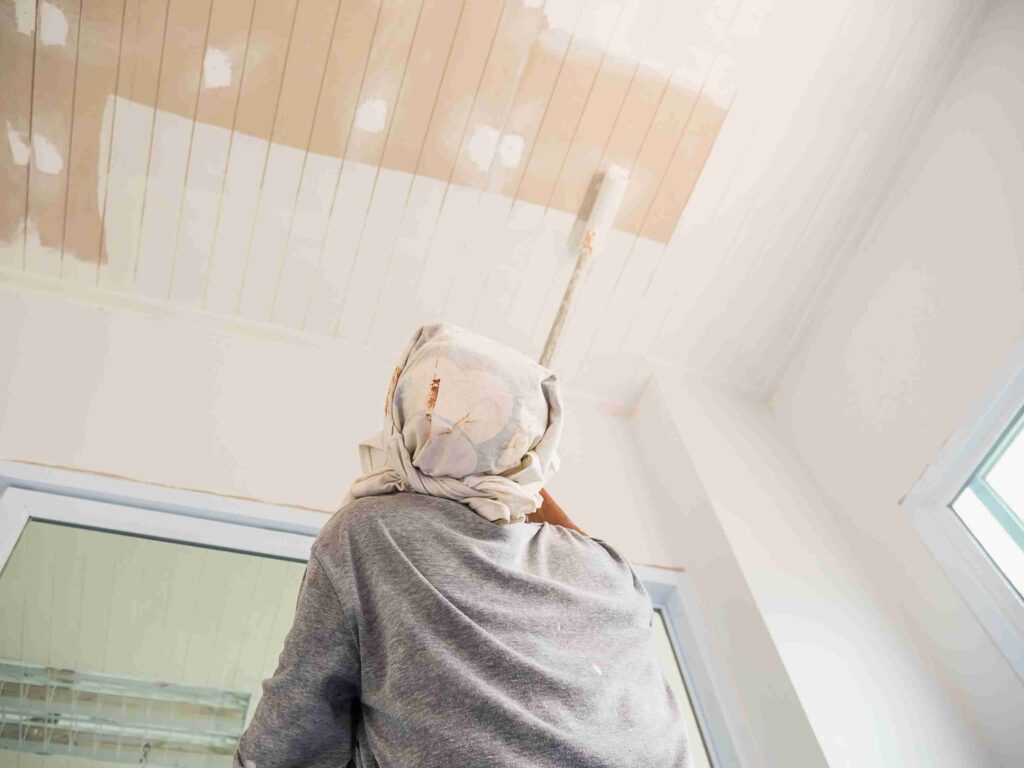Menu

In many Trumbull homes, ceiling paint peeling off plaster is more than just a cosmetic issue—it often signals underlying problems like moisture, age, or poor surface preparation. Over time, this common issue can worsen, leading to flaking, discoloration, and even structural damage if left unchecked. Homeowners may notice patches of old paint peeling off the ceiling or fine cracks spreading across plaster surfaces, especially in bathrooms, kitchens, and older rooms.
Here are five practical steps to fix ceiling paint peeling and restore the plaster to a smooth, lasting finish.
✔ Ceiling paint peeling off plaster is often caused by moisture, poor prep, or old layers.
✔ Identifying the source of dampness is the first step before any repairs.
✔ All loose paint and flaking plaster must be fully removed before priming.
✔ Use bonding and stain-blocking primers specifically designed for plaster surfaces.
✔ Moisture-resistant ceiling paint helps prevent futur plaster ceiling paint failure.
✔ Proper ventilation reduces the risk of ceiling paint peeling in humid areas.
✔ Tools like moisture meters and foil tests can reveal hidden damp spots.
✔ Fixing old paint peeling off ceiling sections early prevents larger damage over time.

Before fixing anything, it’s important to assess the extent of the issue. Ceiling paint peeling off plaster can appear in different forms—from minor surface flaking to deep cracks exposing the base layer. A clear inspection helps identify what caused the failure and how far it has spread.
Moisture is the silent culprit behind most ceiling paint peeling off plaster. Before any repairs begin, the source of moisture must be identified and eliminated to prevent future damage and wasted effort.
Once moisture issues are resolved, the next task is to strip away what’s already failing. Removing flaking paint and weak plaster ensures new layers will bond properly and stay put.
With the peeling paint and weak layers removed, the exposed plaster now needs careful patching. This step is where the foundation for a smooth ceiling is rebuilt.
A well-prepped surface still needs a good primer and the right paint to stay protected. Choosing quality products and applying them with care is key to stopping future plaster ceiling paint failure.
Moisture is often the root cause of ceiling paint peeling off plaster, especially in older or poorly ventilated spaces. While water stains are obvious indicators, hidden dampness behind plaster can go unnoticed until paint starts to bubble or flake. A well-maintained ceiling, on the other hand, can boost appeal and deliver up to a 50% return on investment during resale.
These methods can help uncover hidden moisture before repainting or repairing plaster ceilings:
A handheld moisture meter can quickly measure the moisture content behind painted or plastered surfaces. By pressing the probes gently into the plaster, homeowners can detect moisture levels that may be causing ceiling paint peeling. Readings above 17% often indicate a moisture issue that needs addressing before any repair begins.
Tape a piece of aluminum foil (about 12×12 inches) flat against the ceiling where peeling or flaking is visible. Leave it in place for at least 24 hours; if moisture forms on the inside, the plaster is absorbing dampness from behind. This easy method can confirm the presence of slow leaks contributing to plaster ceiling paint failure.
Infrared thermometers help detect temperature differences, which often point to moisture behind surfaces. Damp plaster tends to stay cooler than the surrounding area, especially near vents, attics, or bathrooms. If ceiling paint peeling off plaster is occurring around colder zones, it may signal hidden moisture pooling inside the ceiling.
Musty smells are a red flag for trapped moisture, even when stains aren’t visible. If a ceiling has persistent odor issues or small specks of mildew, the underlying plaster may be damp. In these cases, moisture can silently trigger old paint peeling off ceiling sections before any water damage appears on the surface.
Using the fingertips, gently press on various sections of the ceiling near where the paint is peeling. Soft or spongy spots may mean the plaster is wet or weakening underneath the surface. These areas are often the first to experience how to fix flaking plaster ceiling issues due to persistent dampness.
If the affected ceiling lies directly beneath an attic or crawlspace, checking that area can reveal the source of the problem. Look for signs of insulation dampness, roof leaks, or condensation on HVAC components. Moisture from above often trickles down and leads to ceiling paint peeling, especially if trapped over time.

Choosing the right products prevents ceiling paint from peeling off plaster. Plaster is porous and tends to absorb moisture, so using the wrong primer or paint can lead to poor adhesion, flaking, and repeat repairs. Fortunately, with the paint and coatings industry projected to reach $303.97 billion by 2032, homeowners have more advanced, reliable products than ever to protect and restore plaster ceilings.
These tips can help ensure long-lasting results and minimize the risk of plaster ceiling paint failure:
Bonding primers are designed to grip slick or chalky surfaces, making them ideal for older plaster ceilings. They seal the surface and help new paint stick firmly, even in areas where old paint peels off the ceiling sections. This type of primer also reduces the chances of peeling due to poor surface prep in the past.
If there are any previous leaks, discoloration, or smoke stains, a stain-blocking primer is essential. These primers create a barrier that stops dark spots or yellowing from bleeding through the topcoat. They’re especially useful in Trumbull homes where ceiling paint peeling off plaster may have been caused by roof or pipe leaks.
Latex primers tend to dry too fast and may not soak into raw plaster properly, especially on repaired patches. An oil-based or shellac-based primer creates a more effective seal over bare or sanded areas. Using the wrong base can lead to early cracking or how to fix flaking plaster ceiling problems down the line.
In bathrooms, laundry rooms, or kitchens, moisture-resistant paint helps prevent bubbling and flaking. Look for labels that mention “mildew-resistant,” “bathroom-safe,” or “high-humidity environments.” This is one of the simplest ways to guard against ceiling paint peeling in high-moisture parts of the house.
Flat paint hides imperfections well but may absorb moisture more easily, especially on patched plaster. An eggshell or satin finish offers better wipe-ability and a mild sheen that helps resist humidity without showing every ceiling flaw. For homes where old paint peeling off the ceiling corners is recurring, sheen can make a noticeable difference.
Primers and paints from the same manufacturer are often formulated to work together. This improves adhesion, reduces curing issues, and leads to a more even finish. It’s a small detail that can help prevent plaster ceiling paint failure from uneven bonding or mismatched formulas.
Yes, in rare cases, extensive ceiling paint peeling off plaster may point to underlying structural stress, such as ceiling sagging or settling. If the plaster shows wide cracks or begins to bow, it’s important to check the joists or supports above. Structural movement can cause both the plaster and paint to fail over time. While most peeling is due to moisture or age, these signs should not be ignored.
Living in a room with peeling paint is generally safe, but caution is needed if the home was built before 1978. Older homes may contain lead-based paint, and when ceiling paint peeling occurs, it could release harmful dust into the air. In such cases, professional lead testing is strongly recommended. Regardless of age, paint flakes from plaster ceiling paint failure should be cleaned up promptly to prevent breathing in debris.
Skipping primer on a plaster ceiling often results in poor paint adhesion and faster breakdown. Without primer, the paint may not bond well to patched or porous areas, leading to ceiling paint peeling within months. Primer also seals repaired spots and helps create an even surface for paint application. This is especially important when addressing old paint peeling off ceiling areas that were recently scraped or sanded.
Yes, if wallpaper or adhesive was ever applied to the ceiling, leftover residue can prevent paint from adhering properly. Even after removing wallpaper, sticky patches or unseen glue can break the bond between primer and plaster. This often results in localized ceiling paint peeling that returns even after repainting. Cleaning thoroughly with a degreaser before priming is key to avoiding this issue.
Yes, but with caution. Chimneys and fireplaces deal with heat, soot, and moisture—factors that can make paint bubble, stain, or peel prematurely. Professionals can help determine if those surfaces are safe to paint or if the painted brick benefits and drawbacks aren’t worth the risk in high-heat areas.
At Trumbull House Painter Pros, peeling plaster and flaking ceiling paint don’t stand a chance. Our team in Trumbull, CT, knows exactly how to handle old paint peeling off ceiling surfaces, stop ceiling paint peeling off plaster for good, and bring cracked, dull ceilings back to life with precision and care. We use high-adhesion primers, moisture-resistant finishes, and proven methods to prevent future plaster ceiling paint failure in every home we serve.
Whether it’s one room or the whole house, we’re ready to roll—reach out today for honest, detailed work in Trumbull, CT, that lasts!